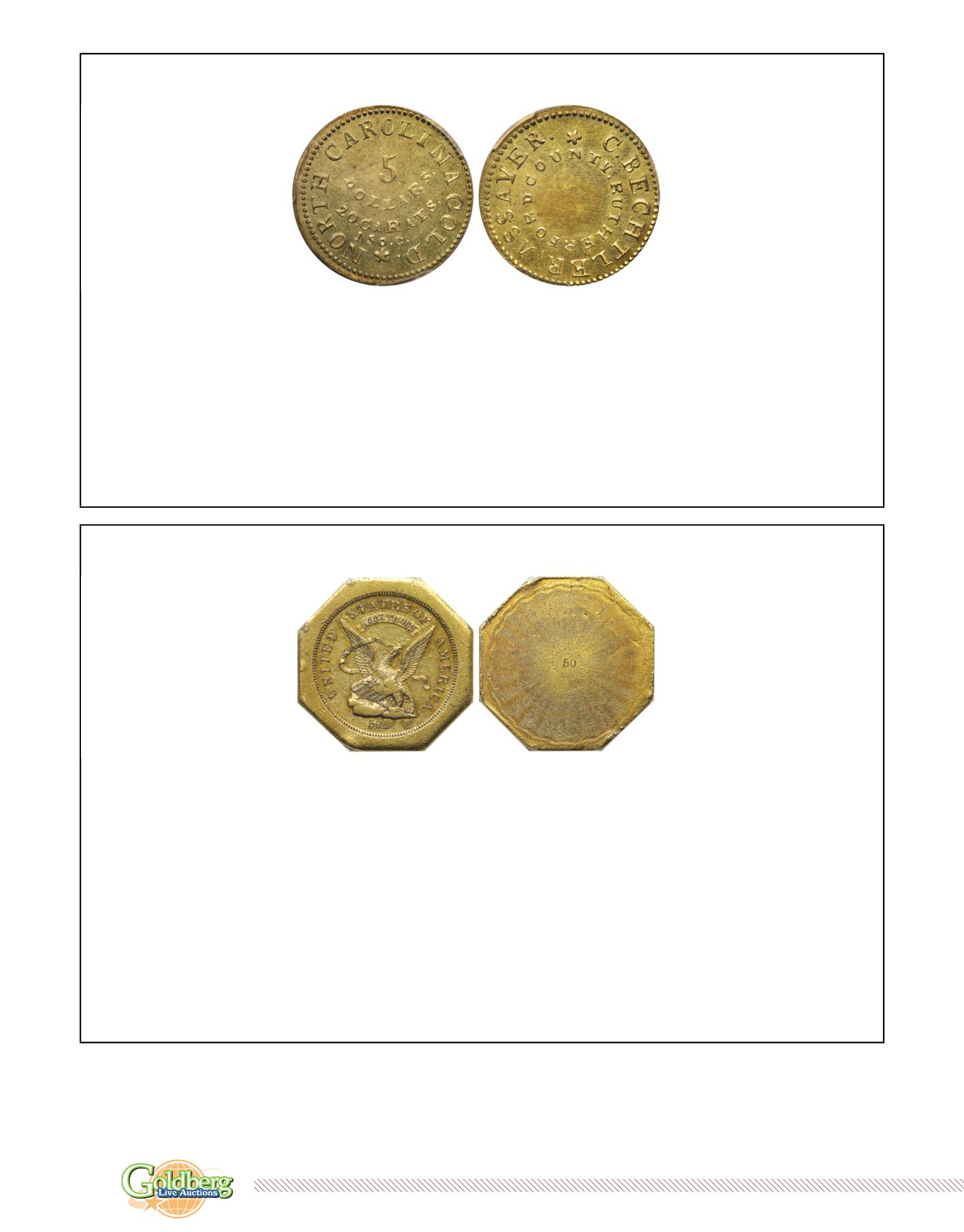
356
|
Session Three - Tuesday, January 27, 2015, 5:00 pm
V
ERY
R
ARE
C
HRISTOPHER
B
ECHTLER
$5, K-15, R
ARITY
7
Enlargement
2207
Christopher Bechtler, 5 DOLLARS NORTH CAROLINA, 150 Gr. 20 Carats. K-15, Rarity 7. PCGS graded AU-55
. One of the second
series of Christopher Bechtler five dollar gold coins, K-15 is a highly elusive type in all grades. Indeed, this is the first example that this cata-
loger can recall handling in a number of years. The obverse die outer legend states C. BECHTLER, ASSAYER with a star below. An inside arc
states RUTHERFORD COUNTY in small letters, with a blank center. On the reverse, NORTH CAROLINA GOLD surrounds the border with a star
below, at the center is a 5, below in descending arcs are the words DOLLARS / 20 CARATS / 150 G. A beaded border is employed on both dies
instead of denticles or the plain raised lip or border used on subsequent Bechtler dies.
Both sides exhibit bold-to-sharp definition from a well-centered and nicely executed strike, not always the case on this rare issue. A lovely
partially lustrous example struck in natural green-color gold. The shimmering surfaces are remarkably clean and free from noticeable marks
and rim bruises. A Choice AU example of one of the important rarities in the Bechtler series.
Pop 7; 2 finer, 1 in 58, 1 in 62
. (
PCGS #
10118
)
Estimated Value ................................................................................................................................................................... $50,000-UP
1851 U.S. A
SSAY
O
FFICE
$50 887 THOUS. L
ETTERED
E
DGE
, 50 R
EVERSE
2208
1851 U.S. Assay Office $50 "Slug", 887 THOUS. Lettered Edge, 50 on Reverse. K-4, Rarity 5.
PCGS graded AU-55.
CAC
APPROVED.
The $50 octagonal "slug," was a golden bastion of California commerce during the first years of statehood. Such pieces were
used in large transactions, being the coin of choice, since the local residents were repulsed by paper money (paper money was made illegal in
the state under the Constitution of 1850.) The octagonal $50 slugs were last made in 1852, after which the Assay Office closed; but the slugs,
themselves, continued in use for many years thereafter. Often, they found their way to the various federal mints, where they were melted into
bullion, then refashioned into federal denominations. When the Gold Rush began, California was a particularly lawless place. On the day when
gold was discovered in 1848 at Sutter's Mill, California was still technically part of Mexico, under American military occupation as the result of
the Mexican-American War. With the signing of the treaty ending the war on February 2, 1848, California became a possession of the United
States, but it was not a formal "territory" and did not become a state until September 9, 1850.
Generally speaking, all varieties of the U.S. Assay Office fifty dollar octagonal coins are very scarce, however, the Reeded Edge varieties are
somewhat more obtainable than their earlier Lettered Edge counterparts. This example, featuring .887 fineness on the ribbon above the
eagle, also has lettering around the edges: AUGUSTUS / HUMBERT / UNITED / STATES / ASSAYER / OF GOLD, / CALIFORNIA / 1851. The
denomination is seen, both on obverse and reverse, on the latter side as a simple 50 at the center. The surfaces present some deep orange-
gold color at the borders, indicative of the copper inherent in the 887-fine gold alloy. While the coin exhibits several corner bumps and rim
abrasions, traces of original luster can still be discerned, making for an especially pleasing piece.
Pop 5; 9 finer, 3 in 58, 4 in 61, 2 in 62
.
(
PCGS # 10208
)
Estimated Value ..................................................................................................................................................................$120,000-UP


